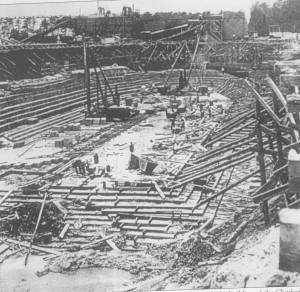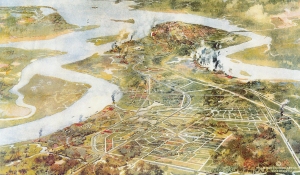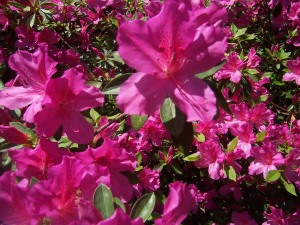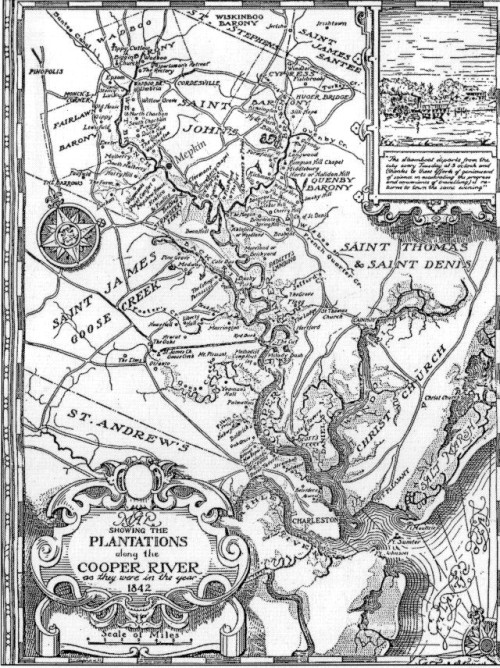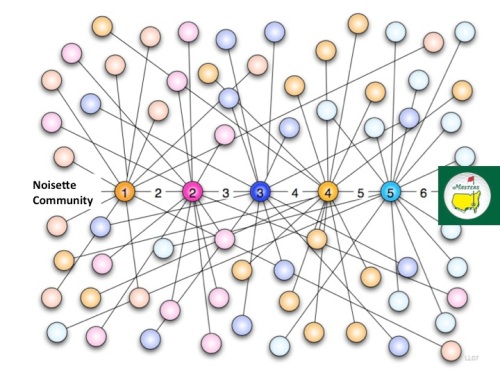Last year, we showed six degrees of separation connecting Noisette and the Masters Golf tournament. Revisit the connections here all in one blog post.
Over the next 6 blogs and before the end of the Masters Tournament on April 11, we will be connecting the area known as the Noisette Community to the upcoming Masters tournament. This will be a history story of sorts and will discuss Park Circle, Liberty Hill, The Navy Yard, Chicora Park and more.
The Noisette community/ North Charleston area was occupied by Indians before Europeans started arriving in the late 1600′s. After the arrival of the Europeans, plantations were strategically set up on the Charleston Harbors and rivers. The Upper Neck area bordering the Cooper River included Marshlands Plantation among several others. Retreat Plantation aka “The Retreat” later became known as Turnbull Plantation. Parts of Turnbull later became a Park which we will discuss in future blogs. Oak Grove Plantation bordered a creek feeding into the Cooper and Paul Noisette bought this plantation in 1865. This is where our story begins. Stay tuned for future posts as we connect Noisette to the Masters Golf Tournament.
In this second installment of connecting the Noisette community with the Masters tournament, we will be following a timeline of events crucial to the formation of the area in North Charleston known as the Noisette Community. The post Civil War time period saw the area begin to transform into a critical social, economical and industrial alternative to the established City of Charleston on the lower peninsula.
- 1872 – The City of Charleston ended roughly 3 miles from the Battery, the “neck area” was largely made up of freed slaves that purchased small tracts of land for small farms. Liberty Hill community was established circa 1871 by freed slaves. This area also employed a significant number of freed slaves in the phosphate rock and timber industry. Phosphate rock was used in fertilizer and these industries began the transformation of the area into a major industrial area for the lowcountry.
- 1895 – Board of Park Commissioners of City of Charleston purchased nearly 600 acres of Retreat Plantation bordering Cooper River. Today, this area is known as Chicora Gardens, the Noisette Preserve and Riverfront Park.
- 1896 – City names Park – Chicora Park. Famed Olmsted brothers were hired for design. Existing Turnbull Plantation was incorporated into their plan
- 1897 – Railway company built a passenger station and extended tracks from downtown to Chicora Park. A bandstand was built, along with a dance pavilion and a small zoo. Chicora Park represents Charelston’s first effort to plan the North area as well as its first substantial experience with professional landscape architects
- 1899 – Land acquired for golf course
- 1900 – City begins pursuing Port Royal Naval Station Relocation
- 1902 – Construction of shipyard begins with the largest pier and dry dock on the East Coast of the U.S.
Part 3 of this series brings us to the North Charleston area around 1912.
The North Charleston Development Corporation was instrumental in master planning the current day Park Circle and surrounding areas into an integrated live, work, play community. They were influenced by the Garden City concept which originated in England and championed by Ebenezer Howard. The area to be developed was in between the present day Noisette and Filbin creeks and was where emerging industrial, naval and shipyard organizations were setting up shop.
In 1912, a group of residents of Charleston purchased appx 5000 acres in the “neck area”. This was the most ambitious development project in the lowcountry. It was a local project, using local capital, with local citizens being the vital players. This group was comprised of accomplished individuals such as Rhett, Montague, Durant, Buist, Hyde and O’Hear. Rhett was the key visionary in this master planning of the area. Rhett believed that the industrial and agricultural sectors could be bound together in a new environment, a new urban form which became known as the New South Garden City. The founding principle was that anyone working in North Charleston may live upon their own farm and grow their own food while living close to work. Truly sustainable living, which we currently are seeing a movement back to these roots. The area, in one grand scope of development strategically looked to bring our railroad and shipping terminals together where business would naturally occur. At fair market rates, sites for factories, villages for employees and suburban type residences were planned.
The creation of a garden landscape was important to the developers. The plan was based on a hub and spokes of a wheel. The next step was to find a planner that could design and work with the vision set forth by this local group. Stay tuned for the details of this process as we get closer to connecting the Noisette community to the Masters tournament.
We’re getting closer to the opening rounds of the Masters and today we’re discussing the 1914 plan of North Charleston developed by William Bell Marquis. Marquis was a young, Harvard trained architect. He was to take the vision created by Rhett and his group (Part 3 of this series) and make the vision a reality. The plan for North Charleston represented a bold effort to build a new city on the “neck.” The plan would draw on planning principles of the Progressive Era, including the environmental aesthetics of the City Beautiful and Garden City movements.
The below map is a general map that holds a clue to connecting this series to Augusta and the Masters. Can you figure out the next connection?
Six Degrees Summary Thus Far:
Part 1 – 1600′s-1865 North Charleston Area History
Part 2 – 1872-1902 – Plantations, Parks and the Navy
Part 3 – 1912 – Local development Group Crafts Vision for New Urban Community
Part 4 – 1914 – Landscape Architect William Marquis plans Park Circle Area
Part 5 – TBD…Teaser…Who hired William Marquis?
Part 4 of this series saw us discuss William Marquis and his plan for the Park Circle area located in the Noisette Community of North Charleston. The connection to the Masters Tournament is becoming more apparent and the previous post held a clue located in the bottom rt corner of the map in the form of text, “PJ Berckmans Co Augusta GA.” Berckmans Nursery aka Fruitland was the first large scale horticultural nursery in the South East US. Founded in 1858 in Augusta GA by Louis Berckmans. In addition to their nursery business, landscape design and community planning seemed a natural fit. The grounds later would become the site of the Augusta National Golf Club. Fruitland Manor was the Berckmans family home. The Berckmans were selected to design North Charleston around 1914 and they selected the young William Marquis as their main man. I’m a little biased but I think he did a pretty good job!
Six Degrees Summary Thus Far:
Part 1 – 1600′s-1865 North Charleston Area History
Part 2 – 1872-1902 – Plantations, Parks and the Navy
Part 3 – 1912 – Local development Group Crafts Vision for New Urban Community
Part 4 – 1914 – Landscape Architect William Marquis plans Park Circle Area
Part 5 – 1914 – William Marquis hired by the Berckmans Group out of Augusta Georgia
Part 6 – Coming soon…Wrapping it all up to the Masters and kicking off the weekend of play
Part 5 of this series brought us to Berckmans Nursery in Augusta Georgia. The Berckmans hired Marquis for the design of North Charleston in 1914. The Berckmans home was known as Fruitland Manor and now is the Augusta National Clubhouse. In 1931, golf Champion Bobby Jones and his business partners created the club and golf course. The two sons of Prosper Berckmans, assisted in the landscape design of the golf course. Many of the plant varieties developed and improved by the Berckmans family still grow today at Augusta National. Many plants like the azaleas and wisteria can be found in the design of Augusta National and the North Charleston Park Circle area and enjoyed today. The connection goes back almost 100 years and some prior history was necessary to get us from the 1st degree on. I hope you’ve enjoyed the ride and the connecting stories!




